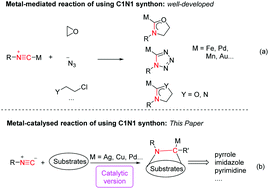Catalytic metal-enabled story of isocyanides for use as “C1N1” synthons in cyclization: beyond radical chemistry
Abstract
Cyclization reactions have attracted considerable attention in organic synthesis with regard to high atom economy and synthetic efficiency towards cyclic architectures. In particular, isocyanide-based cyclization has proven to be versatile for producing N-containing heterocycles among these cyclization processes. Until now, two typical modes of isocyanide-based cyclizations have been established, including the use of isocyanides as C1 synthons and C1N1 synthons. As we know, a series of reviews has documented advances in the use of isocyanides as C1 synthons. However, a critical and specific review with deep insights into isocyanide “C1N1” chemistry remains unexplored. Therefore, we would like to summarize recent advances in the use of isocyanides as “C1N1” synthons. To the best of our knowledge, a series of dual-functionalized isocyanides, such as 2-arylphenylisocyanides and 2-alkynylphenylisocyanides, has been efficiently realised by a model of radical chemistry, and these advances are not included in this manuscript since many elegant reviews have been published. To better illustrate the topic, this review is mainly organized according to various metal catalysts.

- This article is part of the themed collection: 2022 Organic Chemistry Frontiers Review-type Articles


 Please wait while we load your content...
Please wait while we load your content...